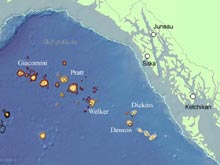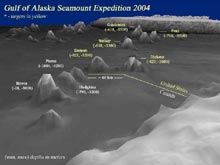
This map of the Gulf of Alaska shows the seamounts we will explore during this expedition. The area within the box is the region that was studied during the 2002 Gulf of Alaska cruise. Areas seaward of the continental shelf contour line are deeper than 1,000 m (~.5 mile). Areas outside the contour line within the box are deeper than 4,000 m (~ 2.5 miles). Black circles indicate seamounts rising up from these incredible depths to within 200 m of the surface. Click image for larger view.
Genomics in Deep-sea Microbiology: What's Down There? What Are They Doing?
Peter Etnoyer,Co-Principal Investigator
Aquanautix Consulting
The 2004 Gulf of Alaska Seamount Expedition will depart July 29 from Seattle, Washington. Aboard the R/V Atlantis, the expedition team's mission is to explore five large seamounts, located 200 miles off Alaska in the northeast Pacific. Scientists will dive to the depths of these ancient volcanoes with the deep submergence vehicle (DSV) Alvin, searching for signs of life in the hadal (very deep bottom) abyss. The scientific party will return August 23 to Astoria, Oregon.
Twenty-four adventurers will spend 25 days at sea. Their mission goals include geologic dating and characterization of the sea floor, deep-sea coral genetics, community ecology, and further exploration of coral-associated microbial communities.
Returning to the Undersea Mountains
For some, the cruise is an exhilarating first-time look at an enchanting deep-sea habitat of coral forests and submerged mountains; for others, it's a long-awaited return to the seamounts. In fact, all four Principal Investigators aboard this cruise also participated in the 2002 Gulf of Alaska Seamount Expedition, as did other scientific researchers, many of the ship’s crew, the sub’s crew, and the cruise coordinator.
The 2002 expedition also surveyed five seamounts, collecting some of the largest "bubblegum" and bamboo corals (from 800 m depths) known in American waters. They discovered rare species in locations far from their previously known homes; and they revealed new information about the life cycles and eating habits -- can you say “cannibalism” -- of amputee crabs on undersea mountain ranges. They also found bacterial populations living in close association with the corals’ mucous layers. The presence (or absence) of these bacterial populations could explain the abundance of commensals on some colonies and the paucity of them on others.
2004 Target: The Kodiak-Bowie Seamounts
This year’s expedition will target five new seamounts -- part of the Kodiak-Bowie Seamount Chain -- stretching along 400 nautical miles in the Gulf of Alaska. The Giacomini, Pratt, Welker, Denson, and Dickens seamounts are central to the chain. They lie in about 11,500 ft of water. Some seamounts in the chain reach to within 85 ft of the sea surface, but the shallowest target on this cruise will be about 1,500 ft below the surface. This is why we need the DSV Alvin: we plan to make regular dives to 2,000, 4,500, and 7,500 ft.
DSV Alvin: A Beloved Titanium Sphere
Crucial to the team's success, the DSV Alvin is the oldest continually operating manned research submersible. It boasts an impressive list of discoveries, including the wreck of the Titanic, entirely new life forms, and hydrothermal vents. Alvin is a titanium sphere, depth rated to 17,000 ft.; it has logged nearly 4,000 dives. The most experienced submersible crew available -- the crew of the DSV2 Alvin -- operates Alvin.
The science team plans to make 18 dives on the targeted seamounts during our 25-day adventure at sea. In the evenings, we will be scanning the seamounts with multibeam echosounders and mapping undiscovered submarine features. As always, we will keep one eye on the weather, which can really kick up in the Gulf of Alaska toward the end of the summer.

This view looks to the northwest across the Gulf of Alaska, along a 400-mile chain of submarine volcanoes. The seamounts closest to us are the youngest, while the seamounts in the background are the oldest. Click image for larger view.
Hotspots and Coral Forests
Seamounts at the northern end of this deep-sea volcanic chain are generally older than those at the southern end. This succession reflects the northward movement of the Pacific Plate over volcanic “hotspots” off the coasts of Oregon, Washington, and British Columbia. These volcanic protrusions propel nutrient-rich currents upward around the seamounts, feeding the plankton blooms that rain down upon these undersea volcanoes.
Seamounts are unique deep-sea habitats. The octocorals here can grow as large as trees, forming groupings that are similar to the forests we know from home. Keratoisis profunda, a bamboo coral, lives the deepest (4,851 m) of all deep-sea corals; and bamboo corals can grow to 30 ft tall on seamounts in the Pacific.
The Adventurers
Taking part in this year's expedition are specialists in the fields of submarine volcanology, marine biology, coral ecology, marine geology, genetics, microbiology, ocean mapping, and marine policy. They represent three U.S. universities, four non-profit research organizations, and the National Oceanic and Atmospheric Administration. Our team will look closely at the diverse communities of deep-sea corals, crabs, sponges, and fish.
We have four Principal Investigators onboard. Tom Shirley of University of Alaska, Fairbanks will look at how crabs and other benthic (bottom-dwelling) invertebrates utilize their deep-sea coral habitat. Randy Keller of Oregon State University will investigate the age of the seamounts in an attempt to unravel their volcanic history. Amy R. Baco-Taylor of Woods Hole Oceanographic Institution will study distribution of deep-sea corals with depth and will compare coral-species composition and biodiversity between seamounts. Peter Etnoyer of Aquanautix will document the community ecology of bamboo and Primnoid coral beds. Both Etnoyer and Baco-Taylor will be collecting samples of all species for species-level identification at the Smithsonian Institution’s National Museum of Natural History.
Additionally, scientist George “G. P.” Schmahl from Flower Garden Banks National Marine Sanctuary will study deep-sea sponges. Naomi Ward and Kevin Penn of The Institute for Genomic Research (TIGR) will use DNA sequencing of bacterial marker genes to carry out a more extensive survey of coral-associated microbial communities than was possible during the 2002 cruise. (TIGR has completed the genome sequence of many pathogens, or disease-causing bacteria, including those that cause cholera, tuberculosis, meningitis, syphilis, Lyme disease, and ulcers. Some deep-sea sponges have been shown to exhibit biopharmaceutical properties.)
Finally, we will have an intern from the Marine Advanced Technology Education Center and an educator from an alternative middle school in Providence, Rhode Island.
Working with a dozen support staff and graduate students, we will embark on our mission with a diverse, well-rounded cruise team.
























